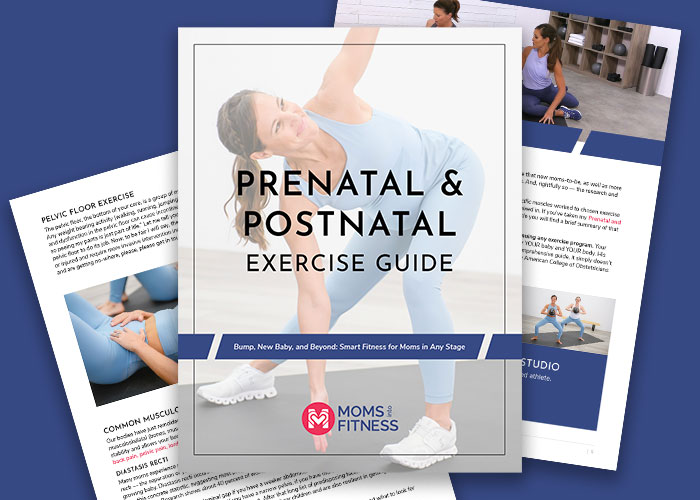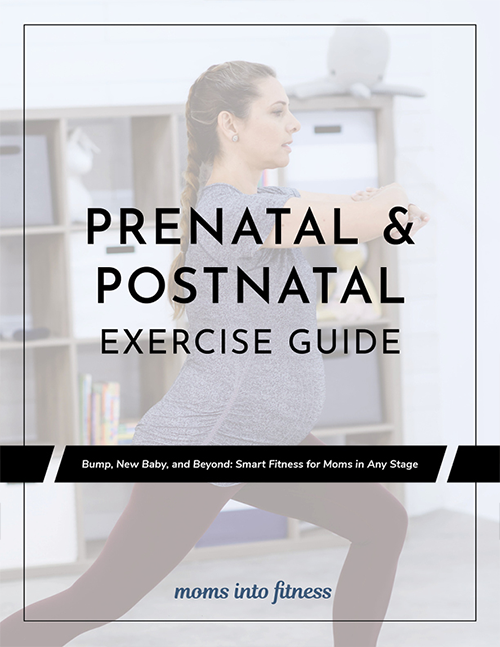
If you were a runner prior to getting pregnant, you can continue to run as long as you adjust your runs over time and as your belly gets bigger. If you didn’t run before you got pregnant, now is not the time to start a running routine.
Here are 10 tips to keep you and your baby safe when running while pregnant. For more in-depth guidance, download our Complete Running Guide for Moms.
#1 — An hour before exercise, eat a snack with complex carbs, protein, and a little fat. Drink about a cup (eight ounces) of water for every 15 minutes of exercise. Please also read the runner’s diet for breastfeeding and pregnancy.
#2 — Stop exercising and seek medical attention if any of the following occur: vaginal bleeding, regular painful contractions, amniotic fluid leakage, difficulty breathing before starting exercise, dizziness, headache, chest pain, muscle weakness, calf pain or swelling. Overall listen to your body! Read all of our pregnancy exercise guidelines.
#3 — Measuring exertion through the talk test is one of the easiest ways to determine what’s too much and what’s too little. As long as you can carry on a conversation while running you are likely in the sweet spot and not overexerting yourself. Gauge your level of intensity by using rate of perceived exertion.
#4 — Avoid hot and humid environments. If you exercise more than 45-50 minutes, please check out our fit pregnancy suggestions.
#5 — Strength training and stretching is an important component of running. It keeps muscles pliable and strong, which helps prevent injury. Use our pregnancy workouts as a supplement to your running routine.
#6 — Running is an aerobic exercise, which can be done every day if you were running every day prior to becoming pregnant. Aerobic, otherwise known as cardiovascular exercise, is designed to improve the level of fitness of your heart, lungs, and the circulatory system. The benefits of cardiovascular exercises are still present 6–12 months after birth. This is why we see some professional runners with better race times after pregnancy.
#7 — It’s usually pelvic pressure and comfort levels that keep you from running later in pregnancy. You can use a belly band for comfort. But know when you should not exercise through pelvic pain.
#8 — Don’t be embarrassed about urinary incontinence, otherwise known as peeing your pants. Your core/trunk is a transfer station for everything that goes on in your body. Running dramatically increases the amount of force through the core, pelvic floor, and legs. This is an important reason for activating your transverse abdominis and pelvic floor (see point #9). The pelvic floor’s primary job is to keep that baby in and then afterwards to keep your insides … well … in. Think of it as a hammock that holds your bladder and reproductive organs in and attaches to the front and back of your pelvis. These muscles work all day long. 24/7. They work in conjunction with the TA to stabilize the core. Any insufficiencies in these muscles can cause pain, incontinence and altered movement. A study by Poswiata in 2014, found that 45.54% of the 112 elite female endurance athletes (non-pregnant runners and cross-country skiers) polled suffered from incontinence. It is so common ladies! We are not alone!
#9 — Don’t forget the deep muscles of the pelvis and core. The pelvic floor is the bottom of your core, affected by simply being pregnant. To keep your core healthy during pregnancy you should incorporate transverse abdominis and pelvic floor exercises. We do this in our core pregnancy workouts.
#10 – Be aware of the gradual change in your center of gravity. Later in your pregnancy this can lead to a change in balance, so some doctors will recommend you run outside instead of using a treadmill. As always listen to your body. If you are tired and feeling clumsy, skip running so you can eliminate any possible trauma to your belly.
Feelings of fatigue and nausea make you want to hug your pillow. But if you have other little ones running around, you know that you have to find some energy somewhere. And just 10–15 minutes of exercise can help boost your energy.
Partway through the second trimester, your cardiac output is up 30–40% above pre-pregnancy levels. So what does this mean? More blood = more oxygen to the muscles = more endurance. Does that mean go run a marathon? No, but it does mean during the second trimester you might be able to do more. Although you should never get to the point of exhaustion or fatigue.
Relaxin, the hormone that lets your pelvis and rib cage expand to fit your baby, also creates loose joint stability. This creates more flexibility, but it also creates an environment for injury if you are not careful. All the postural changes are probably altering your sense of balance. You tend to “waddle” as you walk. This is because your gait (the way you move) is changing to adapt to the extra 20–35 lbs.
In my Prenatal & Postnatal Fitness Specialist Course, we chat about marathons during pregnancy, elite runners benefits and faster running times postpartum, case studies, safe practices, and more! If you are interested in learning more, check out the Prenatal & Postnatal Fitness Specialist Course.
The Moms Into Fitness Studio is packed full of safe and effective workouts to supplement your running. Start your 7-Day Free Trial.
Smart fitness for moms in any stage: bump, new baby, and beyond.

